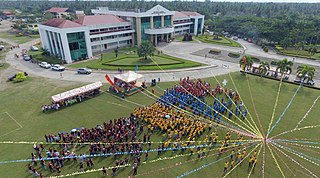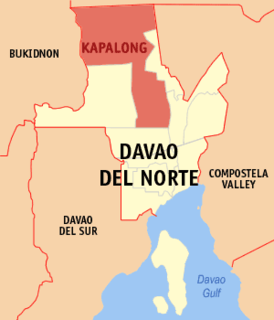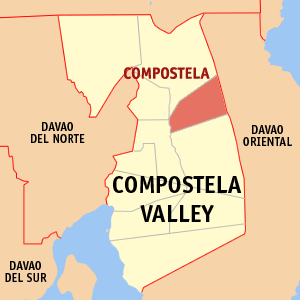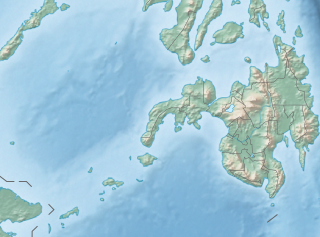This article needs additional citations for verification .(April 2014) (Learn how and when to remove this template message) |
Laak | |
|---|---|
| Municipality of Laak | |
| Nickname(s): The Valley's Last Frontier | |
 Map of Compostela Valley with Laak highlighted | |
Location within the Philippines | |
| Coordinates: 7°50′N125°49′E / 7.83°N 125.82°E Coordinates: 7°50′N125°49′E / 7.83°N 125.82°E | |
| Country | |
| Region | Davao Region (Region XI) |
| Province | Compostela Valley |
| District | 2nd District |
| Barangays | 40 (see Barangays) |
| Government | |
| • Type | Sangguniang Bayan |
| • Mayor | Antonio Ay-Eng Libuangan (PDP-Laban) |
| • Vice Mayor | Milagros Y. Camile (PDP-Laban) |
| • Electorate | 43,492 voters (2016) |
| Area | |
| • Total | 768.00 km2 (296.53 sq mi) |
| Population (2015 census) [3] | |
| • Total | 73,874 |
| • Density | 96/km2 (250/sq mi) |
| Time zone | UTC+8 (PST) |
| ZIP code | 8810 |
| PSGC | |
| IDD : area code | +63 (0)87 |
| Climate type | Tropical rainforest climate |
| Income class | 1st municipal income class |
| Revenue (₱) | 230.3 million (2016) |
| Native languages | Davawenyo Cebuano Kalagan language Mansaka Q12627316 Tagalog Ata Manobo |
| Website | www |
Laak, officially the Municipality of Laak, is a 1st class municipality in the province of Compostela Valley, Philippines. According to the 2015 census, it has a population of 73,874 people. [3]

Compostela Valley, or ComVal, is a province in the Philippines located in the Davao Region in Mindanao. The province, called ComVal for short, used to be part of Davao del Norte until it was made independent in 1998.

The Philippines, officially the Republic of the Philippines, is an archipelagic country in Southeast Asia. Situated in the western Pacific Ocean, it consists of about 7,641 islands that are categorized broadly under three main geographical divisions from north to south: Luzon, Visayas, and Mindanao. The capital city of the Philippines is Manila and the most populous city is Quezon City, both part of Metro Manila. Bounded by the South China Sea on the west, the Philippine Sea on the east and the Celebes Sea on the southwest, the Philippines shares maritime borders with Taiwan to the north, Vietnam to the west, Palau to the east, and Malaysia and Indonesia to the south.

















